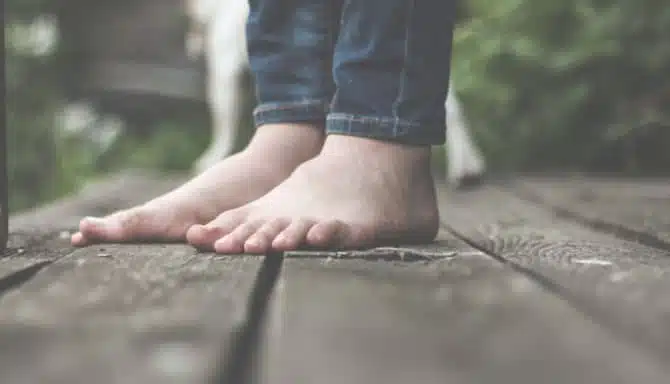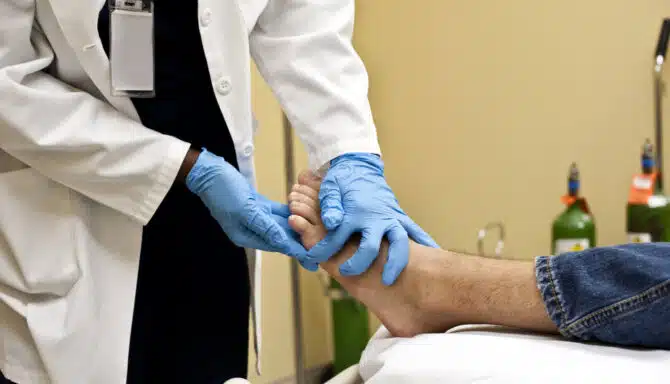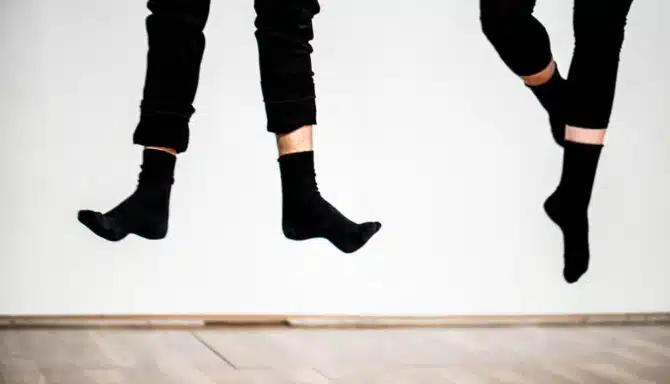Bunions are among the most common sources of foot pain. Bunions are particularly prominent among women, especially those older than 60.
A Bunionette, on the other hand, is less common. When you think about it, a bunionette sounds like a bunion’s younger sibling. And it kind of is.
What Is A Bunionette?
While a bunion is a pronounced bump on the outer edge of the big toe, a bunionette is exactly the opposite. A bunionette is a bump on the outer edge of the little toe.
A bunionette is commonly known as a “tailor’s bunion.” Why? Because tailors used to sit cross-legged. All day. (Apparently, this was done to Tighten Back Muscles so they didn’t wear out as quickly.)
As a result, their feets’ outer edge always made contact with the ground. Over time, the rubbing created a bump on the outside of tailors’ little toes, and further aggravated the foot condition.
And that’s a brief history lesson on a bunionette’s backstory.
The bump may also be a bone spur – a bony outgrowth – caused by osteoarthritis in the fifth metatarsophalangeal joint. The metatarsophalangeal joint is the area between your metatarsal bone (the base of your toe) and your proximal bones (smaller bones close to the head of toe).
Pain associated with a bunionette occurs on the outside of the foot, and tight shoes may exacerbate the condition. Shoes with narrow toe boxes are particularly problematic for those with a bunionette. Narrow toe boxes increase friction against the bony protrusion.
People who have mild to medium cases of bunionettes may experience little to no pain. In these cases, one should take the proper precautions to keep the case mild, and not progress any worse. A mild case of a bunionette may be a small bump on the outer edge of the little toe. A severe case may be that your little toe is overlapping your fourth toe.
Since bunionettes are a progressive condition, they will only get worse over time. This means you cannot reverse what’s already been done.
But, don’t worry, there’s still plenty you can do. In fact, the worsening can be slowed significantly, and it’s absolutely possible to maintain a high quality of life without pain. However, because it’s a progressive condition, the only corrective measure to remove the bunion is surgery.
Causes
According to Harvard Medical, bunions and bunionettes can be heredity, due to arthritis, or misalignment of the foot.
The causes of a bunionette are classified as either intrinsic or extrinsic.
Extrinsic causes include:
- External pressure on the forefoot
- Tight shoes
Intrinsic causes include:
- Genetics
- Foot anatomy
- Faulty mechanics
Foot function and foot mechanics can also contribute to the formation of Bunions and bunionettes. For instance, overpronation, which is the turning in of your foot towards your arches as you are walking, can lead to bunions and bunionettes.
Bunion vs. Bunionette: What’s The Difference?
Whereas a bunion is a result of a deformity and shift to the first metatarsal, a shift in the fifth metatarsal bone causes a bunionette.
The bump that you see is the metatarsal shifting in alignment as the toe begins to point inwards. As this happens, the base of the metatarsal bone shifts outwards causing the bump that is so often related to foot pain. Because the little toe is smaller than the big toe, a bunionette is considerably smaller than a bunion.
Treatment And Prevention
Bunion and bunionette treatment is similar. As such, properly-fitting shoes are an essential step. The team here at First Feet Clinic specializes in Shoe Fitting. No appointment is necessary to find a pair of shoes that fit the profile of your feet.
Additionally, stretching your shoe can provide benefits as it artificially provides additional toe room. This allows your bunionette more space in the shoe.
If foot anatomy and pronation appears to be the cause, investing in Custom Foot Orthotics can be beneficial in the long run. If you’re unsure of the root cause, see a foot specialist for a course of action. Additionally, foot specialists can perform a biomechanical assessment to determine whether orthotics are the right approach.
Anti-inflammatories can also help reduce swelling and pain. Furthermore, you can purchase bunionette Splints for relief and to reduce swelling.
As a final resort, and if physical therapy doesn’t work, surgery is an option. Like for a bunion, surgery corrects the joint and bone deformity. This restores the toe to its regular position. Recovery time can be between 6-12 weeks and it’s recommended you explore all other non-invasive options before considering surgery. Note that because the small toe generally absorbs less body weight than your big toe, bunionette surgery recovery time may be less than for a bunion.
Book an appointment with a chiropodist at Feet First Clinic for professional diagnosis and appropriate treatment plan.










